The ASRock Fatal1ty Z270 Gaming-ITX/ac Motherboard Review
by E. Fylladitakis on September 19, 2017 9:00 AM EST- Posted in
- Motherboards
- Intel
- ASRock
- Mini ITX
- Z270
- 7700K
- Z270 Gaming ITX/ac
The ASRock Z270 Gaming-ITX/ac Review
System Performance
Not all motherboards are created equal. On the face of it, they should all perform the same and differ only in the functionality they provide - however this is not the case. The obvious pointers are power consumption, but also the ability for the manufacturer to optimize USB speed, audio quality (based on audio codec), POST time and latency. This can come down to manufacturing process and prowess, so these are tested.
Power Consumption
Power consumption was tested on the system while in a single MSI GTX 770 Lightning GPU configuration with a wall meter connected to the Corsair AX1200i power supply. This power supply is Platinum rated, and as I am on a 230-240 V supply, leads to ~75% efficiency > 50W, and 90%+ efficiency at 250W, suitable for both idle and multi-GPU loading. This method of power reading allows us to compare the power management of the UEFI and the board to supply components with power under load, and includes typical PSU losses due to efficiency. These are the real-world values that consumers may expect from a typical system (minus the monitor) using this motherboard.
While this method for power measurement may not be ideal, and you feel these numbers are not representative due to the high wattage power supply being used (we use the same PSU to remain consistent over a series of reviews, and the fact that some boards on our test bed get tested with three or four high powered GPUs), the important point to take away is the relationship between the numbers. These boards are all under the same conditions, and thus the differences between them should be easy to spot.
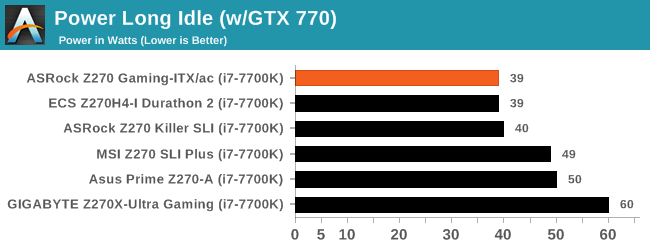

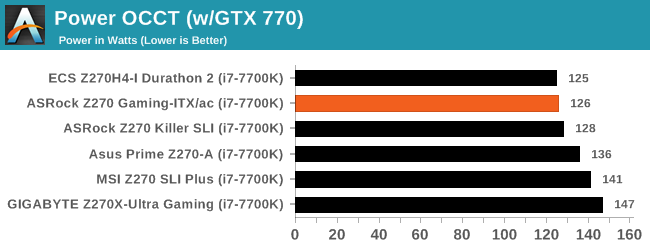
The energy consumption of the ASRock Z270 Gaming-ITX/ac falls exactly where we expected it to be. It is only slightly lower than that of typical ATX motherboards (when their onboard lighting is disabled) and equivalent to that of other Mini ITX motherboards based on the Intel Z270 chipset.
Non UEFI POST Time
Different motherboards have different POST sequences before an operating system is initialized. A lot of this is dependent on the board itself, and POST boot time is determined by the controllers on board (and the sequence of how those extras are organized). As part of our testing, we look at the POST Boot Time using a stopwatch. This is the time from pressing the ON button on the computer to when Windows 7 starts loading. (We discount Windows loading as it is highly variable given Windows specific features.)

The ASRock Fatal1ty Z270 Gaming-ITX/ac displayed good boot time behavior, with a default boot time of 17.6 seconds that can be shortened down to 10.8 seconds by simply tweaking the BIOS quick boot settings.
Rightmark Audio Analyzer 6.2.5
Rightmark:AA indicates how well the sound system is built and isolated from electrical interference (either internally or externally). For this test, we connect the Line Out to the Line In using a short six inch 3.5mm to 3.5mm high-quality jack, turn the OS speaker volume to 100%, and run the Rightmark default test suite at 192 kHz, 24-bit. The OS is tuned to 192 kHz/24-bit input and output, and the Line-In volume is adjusted until we have the best RMAA value in the mini-pretest. We look specifically at the Dynamic Range of the audio codec used on board, as well as the Total Harmonic Distortion + Noise.
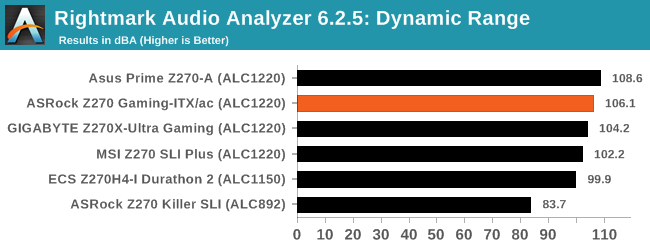
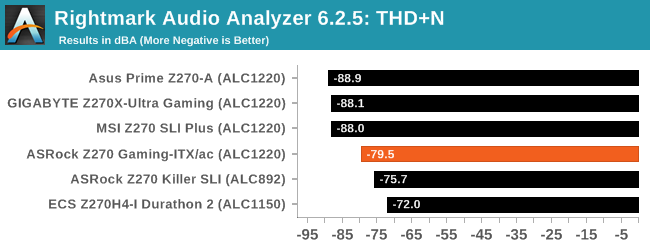
The ASRock Fatal1ty Z270 Gaming-ITX/ac has interesting audio performance figures. It features the Realtek ALC1220, one of the best audio CODECs currently available on retail motherboards. The dynamic range is outstanding, reaching 106.1 dB(A) and significantly surpassing the performance even of other motherboards that are using the same chipset. However, the THD + Noise reading was -79.5 dB(A), which is a good performance figure but falls behind those that we took from advanced ATX motherboards using this chipset, suggesting that, regardless of the designer’s extensive effort, the isolation of the audio circuitry on the small Mini ITX motherboard is not as effective.
USB Backup
For this benchmark, we transfer a set size of files from the SSD to the USB drive using DiskBench, which monitors the time taken to transfer. The files transferred are a 1.52 GB set of 2867 files across 320 folders – 95% of these files are small typical website files, and the rest (90% of the size) are small 30 second HD videos. In an update to pre-Z87 testing, we also run MaxCPU to load up one of the threads during the test which improves general performance up to 15% by causing all the internal pathways to run at full speed.
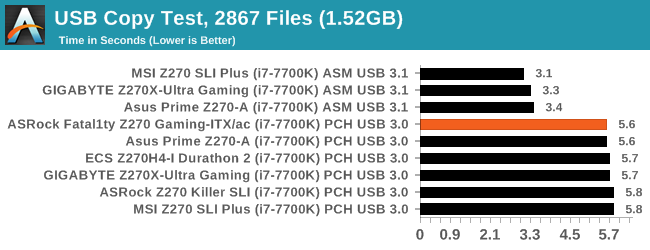
The USB 3.0 performance of the ASRock Fatal1ty Z270 Gaming-ITX/ac is good and directly in line with any Z270-based motherboard that we have tested. Unfortunately, we could not assess the performance of the USB 3.1 controller as Intel’s controllers seem to (still) be incompatible with our USB 3.1 Type-C device, dismounting the device during testing or giving us false readings.
DPC Latency
Deferred Procedure Call latency is a way in which Windows handles interrupt servicing. In order to wait for a processor to acknowledge the request, the system will queue all interrupt requests by priority. Critical interrupts will be handled as soon as possible, whereas lesser priority requests such as audio will be further down the line. If the audio device requires data, it will have to wait until the request is processed before the buffer is filled.
If the device drivers of higher priority components in a system are poorly implemented, this can cause delays in request scheduling and process time. This can lead to an empty audio buffer and characteristic audible pauses, pops, and clicks. The DPC latency checker measures how much time is taken processing DPCs from driver invocation. The lower the value will result in better audio transfer at smaller buffer sizes. Results are measured in microseconds.

With a DPC latency figure of 108 μs, the Fatal1ty Z270 Gaming-ITX/ac may not be the best performer that we have tested recently, yet it undoubtedly is a low reading and representative of the motherboard’s price and class.










41 Comments
View All Comments
GeorgeH - Tuesday, September 19, 2017 - link
100-1 something is overheating and the board is just fine.only1jv - Wednesday, September 20, 2017 - link
that's what i figured, so i tried a different GPU, same result. I even swapped the PSU, same result. Swapped the memory, same result.The only thing i haven't swapped is the CPU but i'm running the Corsair H100i AIO watercooler and have never seen temps on it go above 70c.
I figure it has to be the mobo itself because it would even lockup while in the BIOS.
Oh and yes, i already requested an RMA. Just wanted to share my experience with this mobo after seeing this review and how after a few months it's now failing on me.
Ej24 - Wednesday, September 20, 2017 - link
It was probably the VRM for delivering power to the cpu that was overheating causing the issue. There's no monitoring software for that so most people forget about it. Maybe you got some particularly hot chokes, mosfets, or caps that were just prone to overheating. At any rate, hope the RMA goes well.sonny73n - Thursday, September 21, 2017 - link
Last month I ran into the same problem but with Asus MB. Most of the time "clock_watchdog_timeout" error appeared when it froze. The weather then was about 100F in Southern Ca. CPU stock HSF replaced + case opened = problem solved.The_Assimilator - Wednesday, September 20, 2017 - link
Allow me to introduce you to this magical concept know as "RMA".lucam - Wednesday, September 20, 2017 - link
Still no iPad Pro review yet..:(Beaver M. - Wednesday, September 20, 2017 - link
I would really like to know why they removed 1 USB port at the IO panel.It was still there on the Z170 version.
Also putting in WiFi as part of the board, that cant be removed, is not a good idea either. They might have saved some space on the board, but they didnt use it (for example more USB headers), and instead wasted space on the IO panel. Some people just dont need WiFi and/or Bluetooth.
Also why doesnt AT test if the notorious ASRock USB problem with long or extended cables still exists, which could only be fixed by taking an non-Intel USB chip (either if one is on the board, or an extra PCIe card)? It has been known for at least 5 years...
DanNeely - Thursday, September 21, 2017 - link
They probably used a cheaper 1x USB3.1g2 controller. A year or two ago I don't think that budget version was available yet.bak0n - Thursday, September 21, 2017 - link
I find it odd that they release it now, when the 370's are right around to corner. A bit late to the game for my taste.mickulty - Thursday, September 21, 2017 - link
The 87350D mosfets (actually "power blocks" integrating high and low sides) are actually supplied by TI - NexFET is the range that they're from.